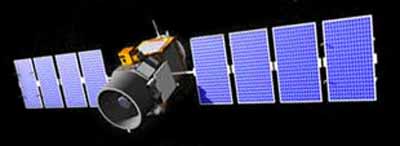Thank you very much for visiting Gunter's Space Page. I hope that this site is useful and informative for you.
If you appreciate the information provided on this site, please consider supporting my work by making a simple and secure donation via PayPal. Please help to run the website and keep everything free of charge. Thank you very much.
CALIPSO

CALIPSO [NASA]
CALIPSO (Cloud-Aerosol Lidar and Infrared Pathfinder Satellite Observations), formerly named PICASSO-CENA (Pathfinder Instrument for Cloud and Aerosol Spaceborne Obeservation - Climatologie Etendue des Nuages et des Aerosols), features a 2-wavelength (532 nm and 1064 nm) polarization-sensitive Lidar as the main instrument to measure aerosol & cloud properties needed to improve climate predictions and as secondary instruments an Imaging Infrared Radiometer (IIR) and a Wide field Camera (WFC).
CALIPSO takes advantage of the experience gained from the Lidar In-space Technology Experiment (LITE), which was developed by NASA-Langley Research Center and flew on the Space Shuttle in 1994. LITE provided the first demonstration of the capabilities of lidar to observe aerosols and clouds from space.
It studies the impact that clouds and aerosols have on the Earth's radiation balance. This balance ultimately controls the temperature of the Earth. CALIPSO will, for the first time, allow scientists to construct three-dimensional structures of the atmosphere so they can better understand the role of clouds and aerosols in the Earth's climate. This enables new observationally based assessments of the radiative effects of aerosol and clouds that will greatly improve the ability to predict future climate change.
CALIPSO will fly in formation with Aqua to provide a unique 3-year coincident global set of data on aerosol and cloud properties, radiative fluxes, and atmospheric state. CALIPSO will fly a 3 channel lidar and passive instruments in formation with Aqua and CloudSat to obtain coincident observations of radiative fluxes and atmospheric state.
Ball Aerospace is responsible for the three scientific instruments within the LIDAR and the communications equipment for the CALIPSO program. Ball will provide an active sensor that probes the atmosphere with green and infrared laser light; a wide-field visible light camera; and a three-color infrared imaging radiometer. This instrument suite will fly aboard the Centre National d'Etudes Spatiales Proteus (Plateforme Reconfigurable pour l'Observation, les Te'le'communications Et les Usages Scientifiques) spacecraft built by Alcatel Space industries. CALIPSO and Cloudsat are scheduled to launch together in 2004.
CALIPSO is no longer a ESSP mission.
| Nation: | USA, France |
|---|---|
| Type / Application: | Earth Observation, Lidar |
| Operator: | NASA, CNES |
| Contractors: | Alcatel Space |
| Equipment: | Lidar, IIR, WFC |
| Configuration: | Proteus Bus |
| Propulsion: | |
| Power: | 2 deployable solar arrays, batteries |
| Lifetime: | |
| Mass: | 560 kg |
| Orbit: | 676 km × 687 km, 98.2° |
| Satellite | COSPAR | Date | LS | Launch Vehicle | Remarks | |
|---|---|---|---|---|---|---|
| CALIPSO (ex ESSP 3, ex PICASSO-CENA) | 2006-016B | 28.04.2006 | Va SLC-2W | Delta-7420-10C | with Cloudsat |
References:
- Ball Aerospace: CALIPSO
- VCL (ESSP 1) - cancelled
- GRACE (ESSP 2)
- CALIPSO (ESSP 3)
- Cloudsat (ESSP 4)
- OCO, OCO 2 (ESSP 5)
- Aquarius (ESSP 6)
- Hydros (ESSP 7) - cancelled
- OCO 3 (ESSP 8)
- CYGNSS (ESSP EVM1)
- GeoCARB (ESSP EVM2)
- INCUS (ESSP EVM3)
- TEMPO (ESSP EVI1)
- ECOSTRESS (ESSP EVI2)
- GEDI (ESSP EVI2)
- MAIA (ESSP EVI3)
- TROPICS (ESSP EVI3)
- PREFIRE (ESSP EVI4)
- EMIT (ESSP EVI4)
- GLIMR (ESSP EVI5)
